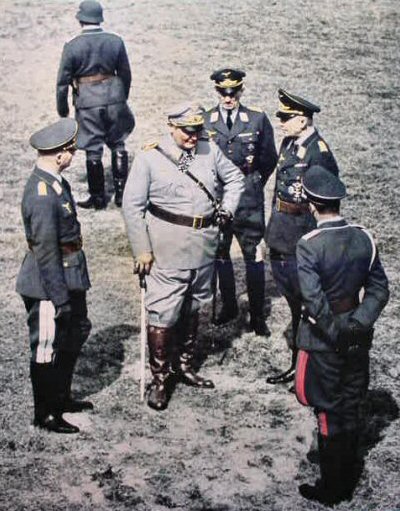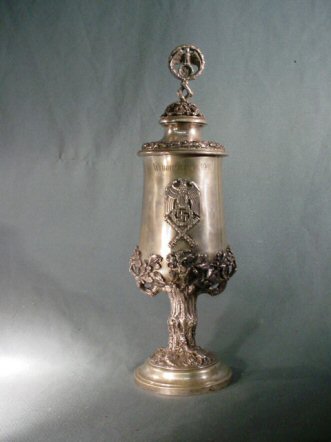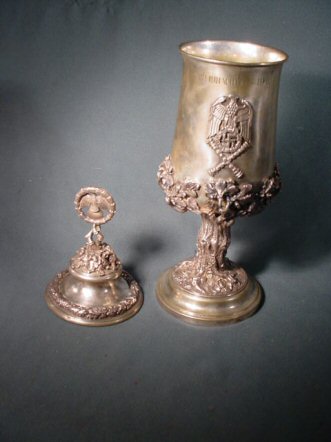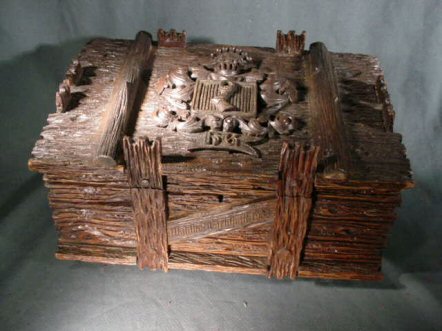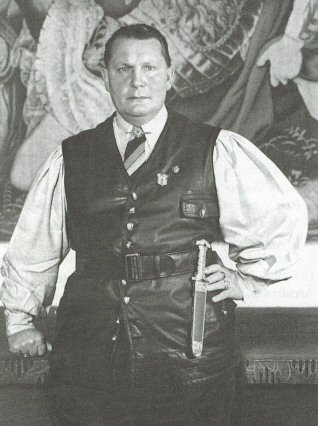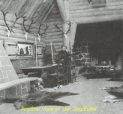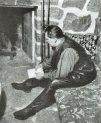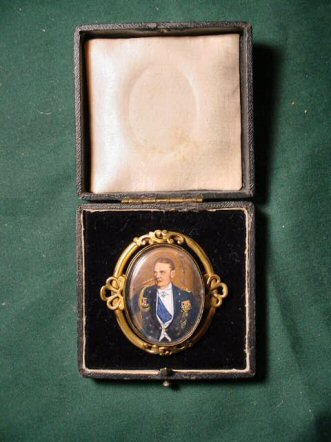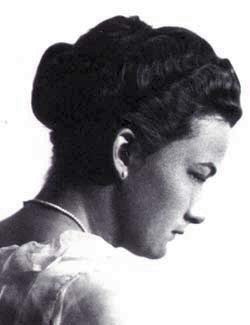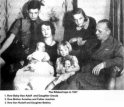|
|
|
|
Hermann Göring
Page 7
|
|
|
||||||||||||||||||||||||||||||||||||
|
Hermann Göring Presentation Goblet (Item GOR 7-1) |
||||||||||||||||||||||||||||||||||||
| DESCRIPTION: The absolute compelling passion that Reichsmarschall Hermann Göring had for collecting art and “Object d'Kunst” was absolutely legendary! Realizing this, many friends, party comrades, and people who wanted to gain favor with Germany's number-two man, lavished gifts upon him, seemingly without limit, and Unser Hermann (our Hermann), as he was known, relished and savored these pleasurable circumstances and opportunities. Göring was often referred to as a latter-day Falstaff and Hitler called him "the Showpiece of the Movement" and the best man I have! As the Nazi Government's second most powerful official, Göring was ready, willing, and able to indulge in his compelling diversions and obsessions, while, at the same time, he built and created the world’s greatest air force and effectively managed his seemingly limitless agendas for the NSDAP and the German Fatherland. He acquired several luxurious homes and ardently collected fine art. Göring did not come empty-handed to his position of power. In World War I he had racked up a very impressive 22 kills as a combat fighter pilot and he won numerous medals and decorations for skill and bravery, including the coveted Pour le Mérite, Prussia's highest award for valor. Göring was, by birth and inheritance, a nobleman and aristocrat and he did, in fact, personify the virtues of the Imperial Class that Adolf Hitler sought to integrate into the “New Order.” Göring called himself an ‘inheritor of all of the chivalry of German Knighthood’ and as his wealth and power grew during the era of the Third Reich, he truly established a lifestyle that even noble princes would envy. Besides all of his other regal residences, his favorite was the sprawling country house that he self-designed in the Forest of Schorfheide, named Carinhalle in memory of his Swedish wife, Carin, who died in 1931. As lord and master of this grandiose estate, he delighted in conducting tours for many visiting dignitaries and celebrities such as the famed American pilot Charles Lindbergh, the Duke and Duchess of Windsor, and a virtual “Who’s Who” of the rich and famous of the 1930’s society world. Huge banquets that were fit for a medieval king were served at the massive dinner table with all the trimmings of Imperial splendor and majesty. Göring’s aristocratic demeanor, together with his convivial personality, made him the ideal host for people that the Nazi Government sought to curry favor with, geopolitical ambitions naturally aforethought! Göring was an enthusiastically ambitious man, holding myriad offices in the Reich's government. His greatest claim to fame was that he was the founder and creator of Germany's modern air force. It was he whose ideas and ambitions led to the use of the early flying corps, such as the glider formations that were used to secretly train future pilots; thereby circumventing the burdensome Versailles Treaty. Later, in 1936, after much intensive training, he sent many of these young flyers to Spain to do battle with the communists. This was the initial "test of fire" for these men and their equipment. Göring was the earliest leader of the SA (Storm Troops) and he was very instrumental in the failed Munich Putsch, receiving serious wounds at the Feldherrenhalle, when the army troops opened fire on the Nazi marchers in 1929. However, this march, even though literally a defeat for Göring and Goebbels through the skillful use of propaganda, turned the incident into a “Victory for the Party” and the major step toward ultimate power! Göring became Minister of the Interior of Prussia just after the victory of the NSDAP in 1933, and was President of the Reichstag at one time. In 1938, Hitler promoted him to the rank of Generalfeldmarschall; then, in June 1940, he became the Reichsmarschall of the Greater German Reich. With this promotion, he became the highest-ranking officer of the three military services; and, Hitler’s heir apparent. Göring held many other offices, such as administrator of Hitler’s Four Year Plan, and then, “Master of the Hunt,” (his favorite office). Even as much as Hitler disapproved of the “blood sports,” such as hunting, he nevertheless honored and gave his approval to his favored subordinate by appointing him Reichsjagermeister and head of the National Forestry Service, a post that Göring relished, indeed! He was a crack-shot rifleman and loved the thrill of the chase. “Horrido,” the German hunting call, was practically his motto! However, as ably as he pursued all these many vocations and duties, his greatest calling was his devotion and ardent dedication to making Germany the most preeminent air power in the world. In many ways, he succeeded in this purpose with the help of some of the greatest pilots that the era had seen such as Udet, Molders, Hartmann, and Rudel, and engineers and designers such as Heinkel, Willi Messerschmidt, and others. There has always been wild speculation among historians as to whether Göring should have pushed more toward the production of fighter aircraft rather than bombers. Certainly, had the jet fighter Me-262 and more V1’s and V2’s been rolling off the lines earlier, the war's outcome may, indeed, have been very different. This will always be an indictment against him and later earned him the nickname (“Herr Meyer”) among the German people. At this point, we get to the real subject of this article: a wonderful Pokal, or goblet, that was presented to the Reichsmarschall on January 24, 1940, as a Christmas present from his former comrades of the famed Richthoffen Squadron. These survivors of the original “Flying Circus” fighter wing had been dubbed the Grey Eagles and they met every April 21st to observe and commemorate the death of the Rotekampfleiger, the Red War Flyer, who was also referred to as the ‘Red Baron.’ Such notables as Bodenschatz, Udet, Loerzer, and Van der Osten attended the meetings at the Berlin Aero Club. Göring, of course, was a very favored member, especially after he became Reichsmarschall and, thereby hangs this tale. It was only natural that these veterans would elect to present their former leader an appropriate gift, thereby, honoring him as a beloved comrade in arms. The presentation of Pokals with the intention of recognizing friendship or rewarding accomplishment is a time-honored tradition with aviators in Germany. The Ehrenpokal, or Honor Goblet, was established as an award in the Great War of 1914-1918, with Richthoffen himself having earned several of them during his illustrious career. After the death of the Red Baron it was Hermann Göring who took command of the squadron and also earned these awards along with many others of the famed squadron. So it was plausible that the Grey Eagles would choose a goblet as the prodigiously appropriate Christmas gift for Unser Hermann!. In the year of his great assumption of power, they simply were extremely proud of their former Kriegskamerad. The goblet is immensely suitable and relevant to the times, and carries a message and a meaning that is fairly obvious to any student, historian, or advanced collector specializing in the Third Reich Era. We will now elucidate on the construction and the motif. The whole of the structure is supported by a base from which grows an oak tree whose bark is gnarled with knotholes and sprawling roots. This is topped three fourths of the way up with a garland of wonderfully sculptured oak leaves that support the body of the goblet. At the lid top there is a banded wreath of oak leaves and above that another potpourri of oak leaves and acorns from which two oak branches hold up another wreath at whose center is the National Eagle and swastika of the “Thousand Year Reich.” The whole idea that preponderates throughout the delineation is clearly the theme of the "Holy German Oak Tree,” and its growth, as compared to the rise of the National Socialist Party and its mythos, all this seemingly growing from these humble roots to the final perceived victory of Nazi Germany’s ambitions, agenda, and destiny. Thus, the Seig, or victory, motif is portrayed by the wreathed swastika at the finial, or top of the lid, while the oak wreath of glory rests at the base of the cover-piece, symbolizing the laurels of victory. The legend, or saying, that is inscribed on the body of the vessel is very appropriate and sums up the entire message very well and it might be said to be “the parable of the oak tree.” Translated it reads: “The Great Oak Tree Only Grows from the Tiny Acorn.” This is an analogy supporting the comparison between the Mighty Oak and the triumph of the Third Reich in the year of 1940. And, of course, this is the year that Hermann Göring achieved the second-highest office of the Reich. The legend on the back goes on to read: "With best wishes to our comrade, Hermann Göring, the supreme (giver of commands) to the German Air Force. From the Old Comrades of the Squadron Richthoffen, January 24, 1940.” On the front of the goblet is the word, ‘Weihnachten (Christmas) 1940’ and underneath this inscription is the down-winged eagle and swastika over the crossed batons of a marshal’s rank. This particular symbol was for Göring, and was created for him alone! It is the symbol that would be found on his stationery, certain glassware, his automobile pendants, as well as many other articles that would be marked with this design peculiar to his unique rank. All in all, this is a very handsome and comely artistic piece, worthy of Herr Göring's taste in art; and it must have been very meaningful to him, considering the particular source of the presentation. Practically every Göring gift presented to him was crafted in silver; and those gifts presented by him to others were for the most part designed and produced by the firm of Herbert Zeitner in Berlin; this firm being the master silversmiths who produced about 90 percent of all silver art that Göring presented to others, and probably 75 percent of everything that was presented to him. After it became lucidly apparent that this was Göring's clearly defined preference in artistic offerings, silver definitely became the metal of choice, and was considered the sacred metal of the Third Reich. This can be perceived through the viewing of hundreds of presentation articles that have turned up in collections and museum archival groupings. Silver and not gold was considered to be the personification of purity. Heinrich Himmler, the Reichsführer-SS helped this accepted NS view with his pronouncements in his bombastic tirades and vilification of the yellow metal as being the base source of world Jewish financial power and manipulation of the working classes. Göring, however, in his position of supreme power simply chose to ignore the directives of Himmler whenever he chose to wear gold or to have certain articles such as rings and pendants, etc., crafted in gold by Zeitner and others. Who would even think of criticizing the preferences of Hitlers ‘Paladin?’ The goblet is clearly stamped with the peculiar ‘Z’ logo for Zeitner, in a circle, with the two crosslines at the top branch of the ‘Z’, all encircled and with the word "Berlin" below it. This mark is also on the inside of the lid. The workmanship on the Pokal is even more so a signature of the Berlin silver master than the logo. It truly is a masterwork of artistic accomplishment and also a fantastic evidential archetype of the Third Reich saga to that time. Although the goblet is definitely the work of Herbert Zeitner, we believe the engraving to likely have been accomplished by one of the members of the Grey Eagles, or associates. We have seen this to be the case in many presentation pieces. The engraving is well consummated and typical of this period with the major letters and capitals typically shaded. The overall height with the lid in place is 16 1/2 inches, and at the widest point it measures about 5 1/2 inches. The circumference of the base is 5 inches. This is a really remarkably beautiful piece of silver sculpture and even more importantly, it is, without a doubt, a very significant and imposing example of the skilled craftsmanship of this silversmith extraordinaire and the recognized imperatorial acumen of its former owner, Unser Hermann.
PRICE: SOLD |
|
|||||||||||||||||||||||||||||||
|
Rustic Lodge Chest from Hermann Göring’s Carinhalle, 1933 (Item GOR 7-2) |
|||||||||||||||||||||||||||||||
| DESCRIPTION: Here is an incredible oak chest completely hand carved and originally from the hunting lodge of Hermann Göring, the second-highest official of the Third Reich. This stunningly beautiful art piece is done in the traditional Black Forest style of very rustic-looking furnishings that the ‘master of the hunt’ loved so much! Göring’s off-duty life centered around the forest, where he indulged in his favorite sport, hunting. He was honored by Adolf Hitler when the Führer bestowed upon him the title of Reichsjagermeister in 1934, having authority over all hunting and forest preservation. His edicts and game laws were a model for those still enforced throughout Europe, today. He was the prime mover for the prohibition of vivisection throughout the Reich, and, of course, along with that, Kosher slaughter was also banned in that year. In his office he had a sign saying “Wer Tiere Qüalt, verletz das Deutsche Volksempfinden,” (He who tortures animals wounds the feelings of the German people). He was hailed worldwide as a conservationist of great imagination and achievement. In 1933, Göring decided to build a great country mansion to be dedicated as a memorial to his first wife, Carin, whom he continued to love to the end of his life. He placed this state home in the middle of a 100,000 acre tract in the forest of the Schorfheide (a hunter’s paradise). His architects made it take shape in the form of a vast baronial mansion for a man who reminded many of a feudal monarch. Various sections of the house were decorated differently with various motifs in furniture and tapestries. Even the door handles were considered works of art. It was the fulfillment of a dream he had worked on all of his life to make come true. He personally planned everything himself with the aid of such famous designers as Hulbe of Hamburg and Anton Possenbacher of Munich. The setting was perfect the placing of the house without fault. That was the most marvelous part of his personal achievement. Wherever you look and from whatever window you gaze there is always a glimpse of the lake or the forest and inside too you would look up to the clear pine roofs and open beams. Oak was a key word to Hermann Göring. See our description of the presentation goblet B(it looks like a tree) to him at (make link). He recognized the significance of the mighty oak to the Teutonic German past and its mystical powers. Der Heilege Baum was important to Hermann Göring and it was the predominant wood used throughout his several estates, but especially here in Carinhalle. One of the Gute Zimmer” or state rooms, was the hunting hall, where the entertaining took place for important diplomats, sportsmen, and hunters, who were lucky enough to be invited to participate in elaborate hunting parties that the host would organize and in this hall almost everything was decorated or built with rustic décor and there were many gifts that were presented to him here to include guns, huntsmen’s horns, boar spears, archery equipment, and various pieces of hand-carved furniture. Now we get to the subject of this dissertation. This chest that we offer comes from a grouping of such items long hidden away in east Prussia--hidden from the barbarian Russian officials during the occupation years. Knowing full well of the destructive tendencies of the Kulturtragers (barbarian beasts!) one of Hermann Göring’s workers at the Schorfheide estate removed many art objects and other items such as furniture, some jewelry, guns, and paper items from the estate after Göring abandoned it in 1945. The Russian subhuman troops did not find much on their approval because the employees with devotion to their boss and the knowledge of what was to come under the heel of the cruel animalistic system felt that these things belonged to Germans and to hell with Moscow! It is a testament to the Germanic will and determination to preserve beauty and culture that allows these important historical treasures to be offered today instead of being used as diaper dispensers in some commune in the Russian wastelands. The chest we offer is an incredible example of Black Forest art with overtones of medieval design and splendor. The main feature is a wonderful depiction of the Göring family crest fully carved in high relief with H.G. (Hermann Göring) carved in relief under it. The floral design is incredible surrounding the armored arm with the ring of the ancient Göring-family crest. Above this you can see the crowned helmet that signifies the Göring family’s fealty to the Prussian kings and their royal bloodlines as well. The front of the chest under the keyhole has a plaque that says Waldhut Carinhlle. This means ‘forest hut.’ This description was certainly fitting in 1933 when the case we present here joined the rest of the all-rustic trappings. In 1933, Carinhalle was in fact a forest hut, but soon after became a veritable mansion. The chest of gnarled oak was said to be from oak branches from a very old tree stump in the forest and assembled to be artistically incorporated in this magnificent Black Forest piece. It may have been one of the very first presentation gifts to Göring soon after the purchase of the land possibly even before the house was built. In any case, it is perfection in the rustic mode and must have made the future Reichsmarschall enormously happy to receive it. The chest is big, measuring 16 inches by 10 ½ inches across its top and almost 7 inches deep. There are protrusions that also serve as legs that are 9 inches high at 6 places supporting the chest body. The whole depiction would seem to approximate the Jager boxes that are much bigger and are actually found throughout the German forests and placed at various locations and filled with supplies that a hunter might need such as gun-cleaning supplies, first-aid equipment, rope, and sometimes jugs of water, etc. This custom was also promoted and was the idea of the Master of the German Forest ‘Unser Hermann’. This was what the German people called him, the most beloved NSDAP leader. We are very proud to offer this priceless historical relic (with a price).
NO LONGER AVAILABLE |
|
||||||||||||||
|
Woman’s Brooch Given by Göring to Frau von Ribbentrop (Item GOR 7-3) |
||||||||||||||
| DESCRIPTION: Here is a very nice little brooch with the picture of Hermann Göring in full-dress air marshal’s uniform contained within. This would be the height of vanity to present to the wife of such a high Reich official, but Hermann was certainly no slouch when it came to demonstrations of gall! He was one of the greatest of WW I aces, the creator of the early SA, the architect of the modern German Air Force, the ultimate hunter and sportsman, the obvious winner at the Nuremberg revenge trials, and the debates between he and “Chief Justice” Jackson. He was a great orator and shrewd politician; a renaissance man, but and introvert personified! He not only surrounded himself with ultimate opulence, but also would present small, but neat house gifts to those visiting his Carinhalle estate. A lady such as Frauvon Ribbentrop would often find tucked in her dinner napkin a little token such as this with the host beaming with delight as she opened it and suddenly viewed the gift now revealed. We have heard of only one other found and that was practically identical and was given to the wife of Dr. Robert Ley, the DAF chief and close friend of Göring. The brooch measures about 2 x 2 inches and the picture is covered in glass, which is scratched in places. The whole of the picture is set into a framing of rococo design constructed in brass. On the back are the engraved words, “Meiner Lieber Frau Ribbentrop.” Why no ‘von’ accompanying ‘Ribbentrop?’ Göring was born into Prussian nobility and aristocracy, but the family never received the coveted ‘von’ that was bestowed usually by the ruling Hohenzollern kings. So great was Hermann Göring’s perceptions of his own greatness and power that he felt that these ‘von’’s were no better than he, thus when gifts were given and letters written, the noble title of ‘von’ was usually eliminated. This was usually acceptable between important personages and landed gentry of Prussia, but no commoner would dare to forget the ‘von.’ The picture in the brooch is similar to the picture on the front of a book on Göring. The brooch is in fine condition and has its original cases with fitting for the pin back arrangement. This is a very handsome and important historical piece.
PRICE: SOLD |
Contact Us |


